This vegan butternut squash risotto is my idea of the perfect autumn comfort food. Creamy, hearty, and indulgent, it's a delicious dish that'll warm you up as the nights get longer.

Featuring soft chunks of squash, creamy risotto rice, and the bright flavours of fresh sage and lemon, I like to top it all off with crispy fried sage leaves and the roasted squash seeds.
Whereas many butternut squash recipes call for you to peel the skin, I like to leave it on. Not only is it edible and tasty – it also reduces food waste and saves you time when preparing the ingredients.
For more creamy rice in your life, see these recipes for vegan beetroot risotto and lemony smoked tofu risotto.
I create new content every single week. Subscribe to keep in touch and get a free download of The Vegan Kitchen – My Top 10 Tips.

Should I peel the butternut squash?
When preparing the butternut squash, it's up to you if you want to peel the skin or not. I always leave it on since it'll soften in the oven and is perfectly edible.
With squash and pumpkins in general, the skin is usually fine to eat. It mainly depends on how tough that particular variety is and whether it actually tastes nice. Generally speaking, the smaller the squash, the better the skin is to eat.
If you like your squash with the skin on, I’d suggest also checking out these recipes for vegan butternut squash pasta bake and roasted pumpkin couscous.
Fresh sage v dried sage
I use dried sage all the time in my cooking, but I would highly recommend using fresh sage in this risotto. The leaves have a strong, distinctive flavour that I personally love.
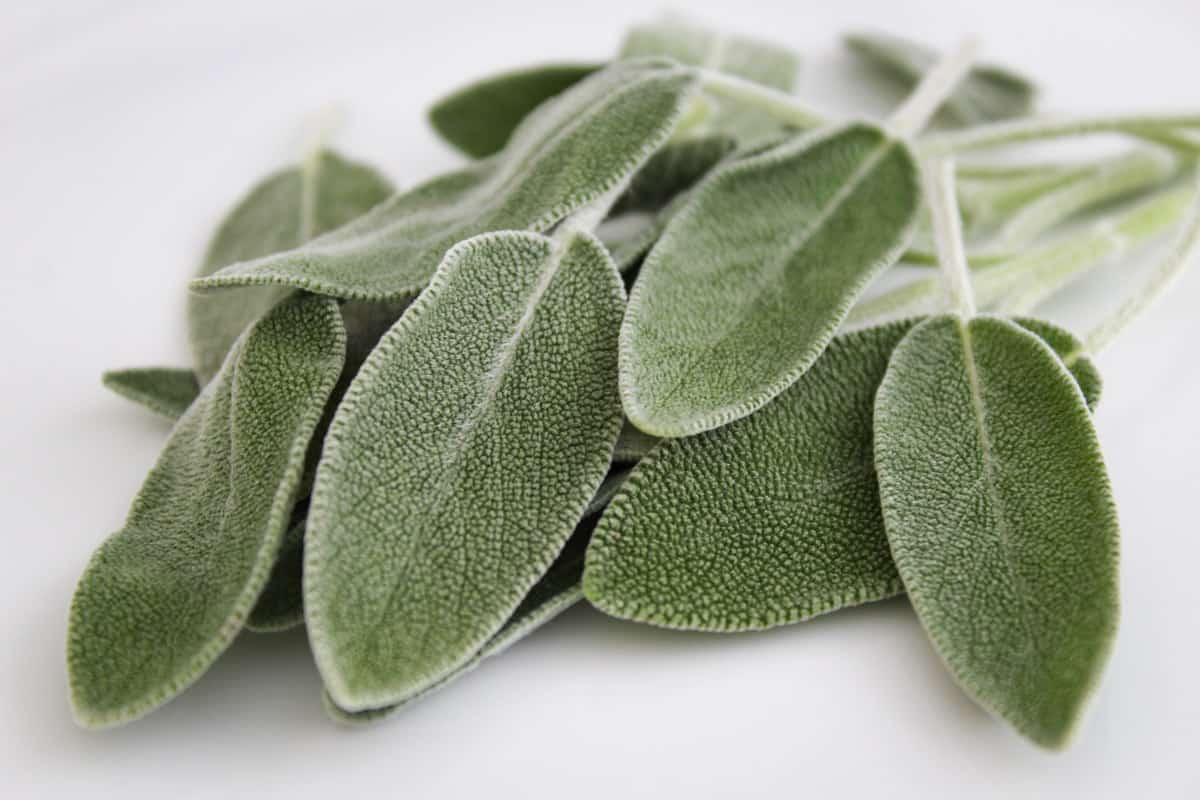
If you have fresh sage leaves, it also means you can fry some of them to add a crispy and delicious garnish to your dish (see recipe notes for more info).
If using dried sage, I'd start with one teaspoon and add more to suit your taste. You can either add this to the stock pan or stir it in once you start adding liquid to the risotto rice.
How to make vegan risotto creamy and cheesy
The recipe notes below contain info on how to make your vegan risotto creamy and cheesy. For a deep-dive into all my dairy-free tips and tricks, check out my main recipe for creamy vegan risotto.
What you'll need
To make this creamy risotto, you'll need:
- Butternut squash with the ends and seeds removed
- Fresh sage for its distinct flavour and fragrance
- Risotto rice to create the creamy texture
- Nutritional yeast for plant-based 'cheesy' notes
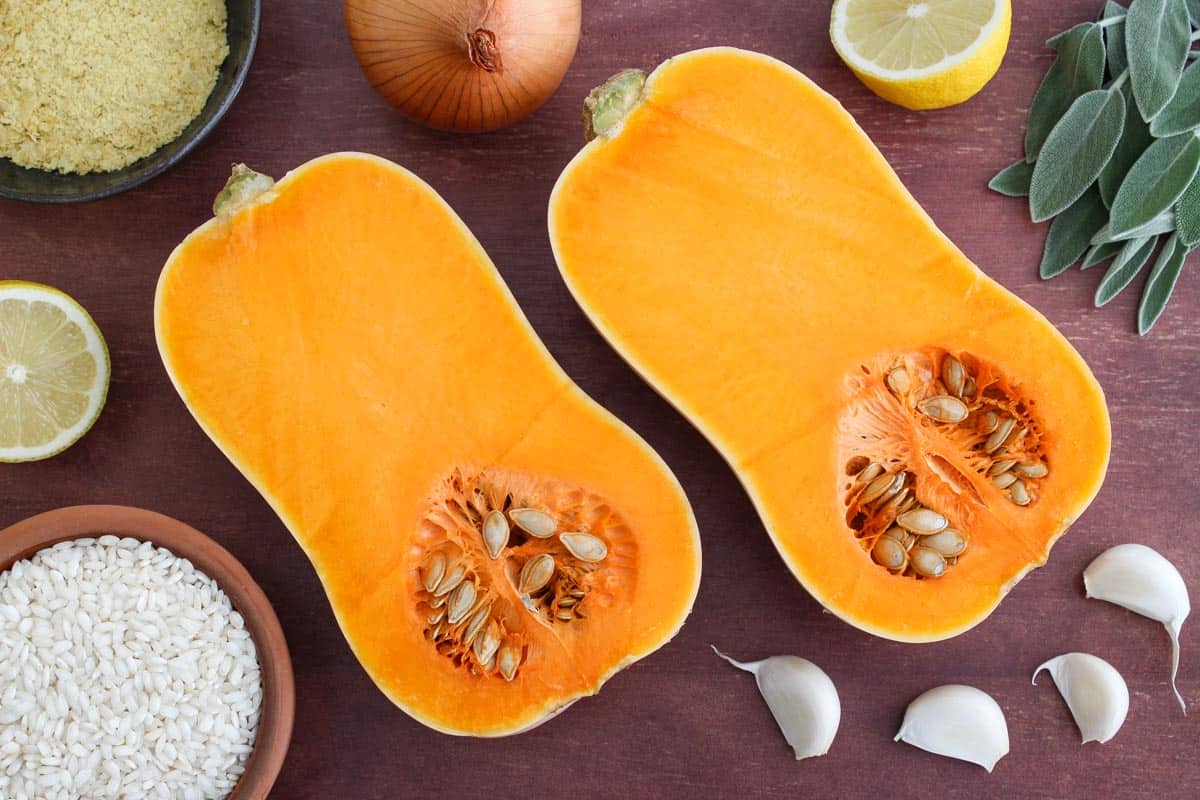
How to make vegan butternut squash risotto
Preheat the oven to 200°C (390°F). Give the squash a quick rinse, cut in half, remove the tough parts of the stem and bottom end, scoop out the seeds with a spoon, then chop into 1-inch cubes. (You can roast the seeds as a garnish or snack).
Drizzle one tablespoon of the olive oil over a large oven dish, then add the cubed butternut squash and spread evenly. Sprinkle with salt and pepper and roast in the oven for around 25 minutes or until tender.

While the squash is roasting, heat the vegan stock in a saucepan. In a separate large pan, soften the onions for 3-4 minutes before adding the garlic and sage. Season with salt and pepper, stir well, and cook for a couple of minutes.
Turn up the heat, add the risotto rice, and stir constantly for a minute or so to avoid it catching on the bottom. Add the white wine and lemon juice (but not the zest), stir well, and then reduce the heat.
Start to add ladles of the stock to the rice, stirring regularly. The idea is to 'beat' the rice to help release the starches and make it creamy. Don't drown the rice in stock, but also don't let it dry out too much. 'Sloppy' is the best word I can think of to describe it. The heat should be fairly low throughout, so that the rice is bubbling gently but not boiling.
Continue this process for around 15 minutes, before adding the nutritional yeast, lemon zest, and plant-based milk. Stir well and cook for another five minutes, adding as much stock as you need to the pan. 1 litre of stock should be enough for 300 grams of rice, but add extra liquid if necessary.

Once the squash is cooked, remove from the oven and mash half of it in the oven dish. Stir the mash and cubes into the risotto, adding a little more hot water or stock if necessary.
After the rice has been cooking for a total of 20 minutes, it should be 'al dente'. Each grain should be cooked through but still hold its shape. It may take longer than 20 minutes depending on how hot your stock is and how much you're cooking.
Once the rice is creamy and cooked through, adjust the seasoning (I sometimes add a little extra chopped sage) and then turn off the heat.
Optional step
After turning off the heat, I like to stir in a generous spoonful of plant-based butter and then cover with a lid for a few minutes. I find that this gives a nice gloss to the final risotto.
Serving suggestions
- A drizzle of extra-virgin olive oil
- Roasted squash seeds
- Crispy sage leaves (see recipe notes)
- Vegan parmesan
- Other toasted seeds or nuts
- Homemade cashew cream
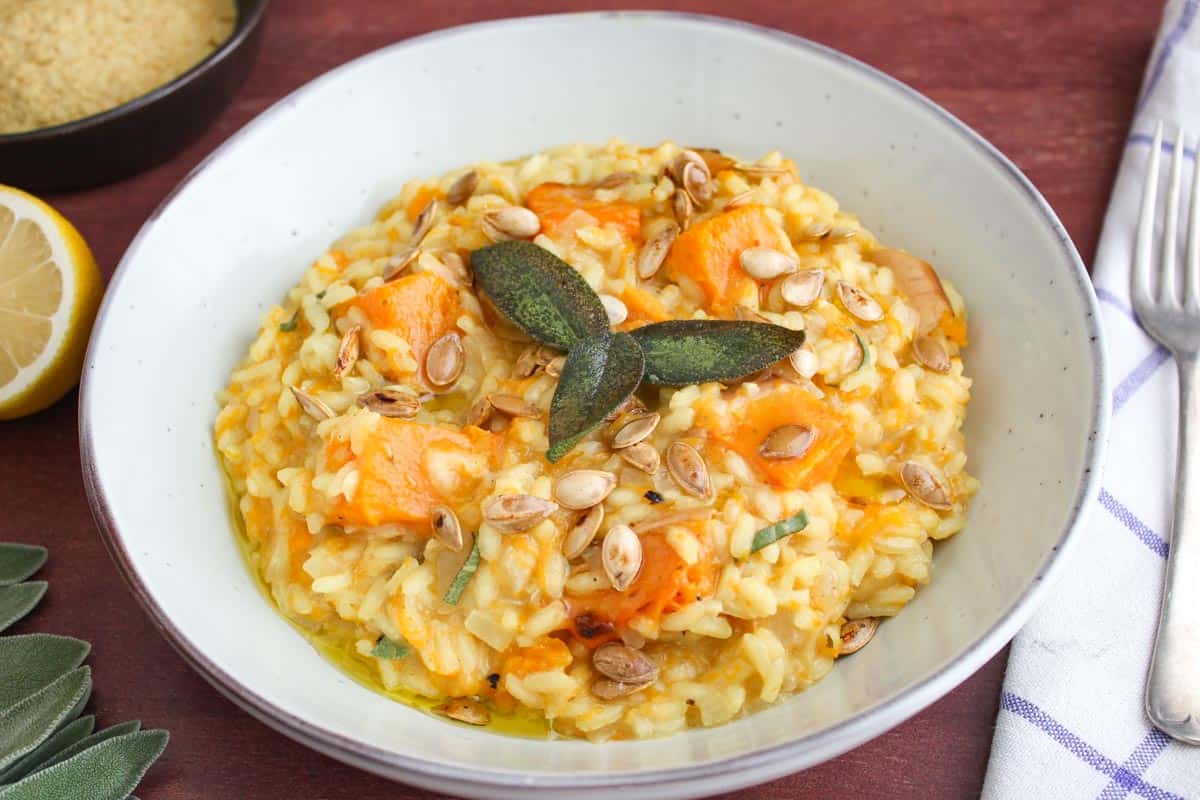
Recipe FAQ
You can swap out the butternut squash in this risotto for any winter squash. If the squash you’re using has very tough skin, you may want to remove this before cooking.
Pumpkins are a variety of winter squash and would be great here. Note: Pumpkins grown for Halloween carving (those big orange ones) are generally not very good for a recipe like this. They tend to be quite bland, fibrous, and better suited to something like this Halloween pumpkin soup.
If you need to ensure that this recipe is 100% gluten-free, use a plant-based milk and vegan stock that are certified or labelled as such (as well as any plant-based cream or crème fraiche you add).
Variations and tips
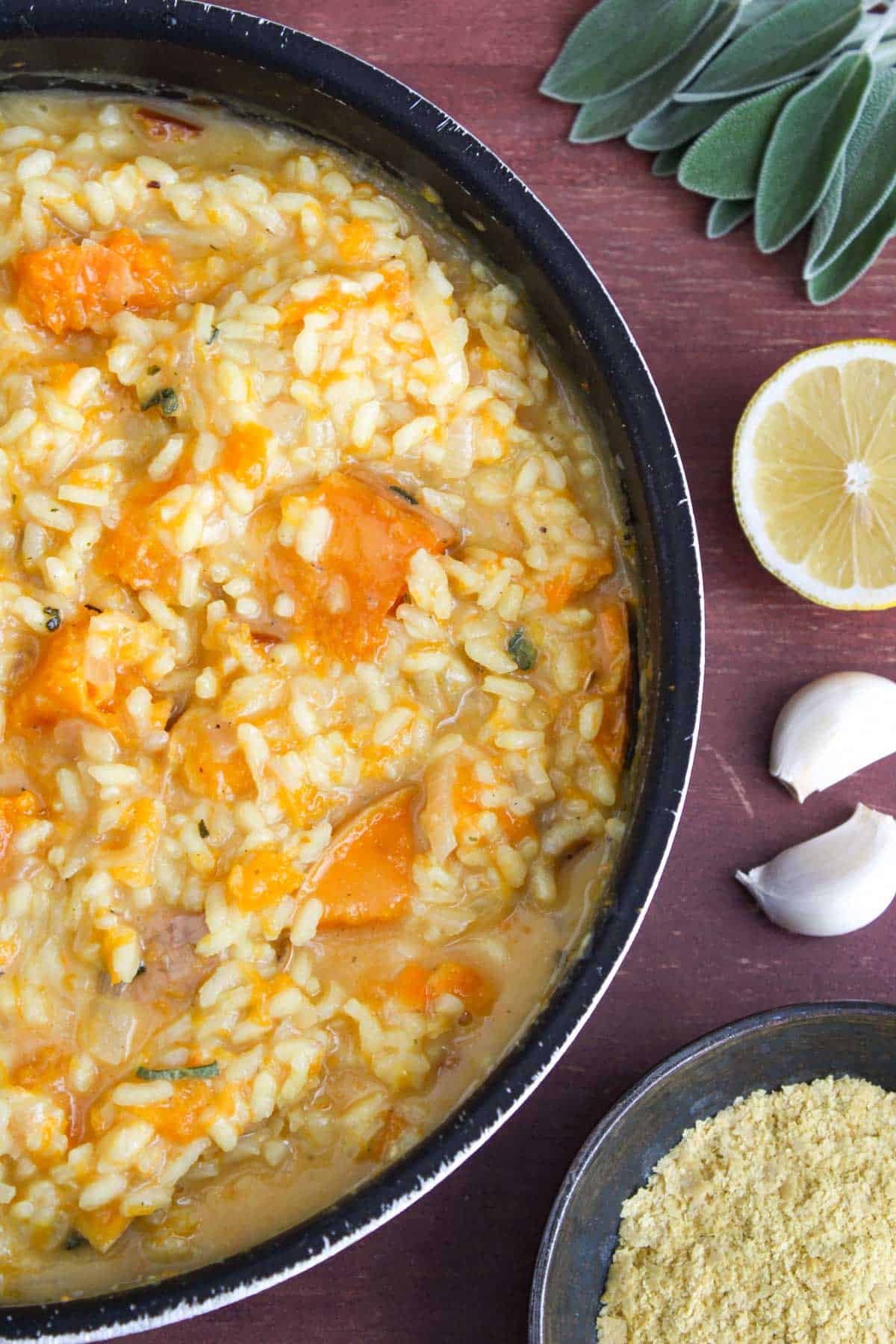
- Squash cubes: I like decent-sized chunks in the final risotto, but you can cut these smaller if you like (this will also speed up the roasting time).
- Adding the stock: If you want a quicker method, you can add stock powder or a crumbled cube to the pan and then gradually pour small amounts of hot water from a boiled kettle.
- Quantity: If scaling up the amounts, just be aware that the rice may take longer to cook.
- Plant-based milk: I’d recommend using unsweetened oat, rice, or soya milk for this risotto.
- Add more veg: If you want to take this recipe up a notch, add finely chopped carrot (1 medium) and celery (2 sticks) when frying the onion. This trio of veg is what the Italians call a 'soffritto' and it adds more depth to the base.
- Texture: After cooking for 20 minutes, each grain of rice should be cooked through but still hold its shape. If you need to cook it for longer, just be careful not to let it go too mushy.
- Pan: If possible, you should use a wide, high-sided pan or skillet to cook risotto. It’s not a deal-breaker, but it does help the liquid to evaporate more evenly (and so the rice will cook more evenly).
How to store vegan butternut squash risotto
Risotto is best when freshly cooked. It'll go slightly gluey and mushy in the fridge, however this still tastes great when reheated or turned into arancini (breaded risotto balls) or risotto fritters.
Refrigerate: Store risotto in the fridge for up to three days. Reheat in the microwave or in a pan with some additional water, but don’t expect it to be as good as when you first cooked it.
Freeze: It is not recommended to store cooked risotto in the freezer. The rice will become grainy and lose its texture, so it’s best to refrigerate instead and use it up within a few days.
Keep in touch
Subscribe below to receive a weekly newsletter with my latest recipes. Nice and simple. No pesky pestering. No spam (which wouldn’t be very vegan anyway).
More vegan recipe ideas
If you liked this recipe, you may also enjoy:
Full recipe
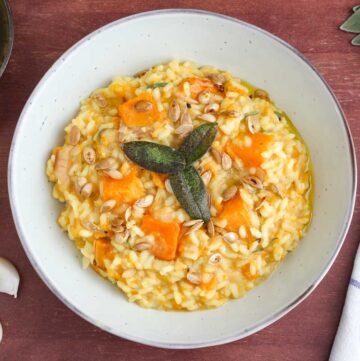
Vegan Butternut Squash Risotto (Creamy + Delicious)
Ingredients
- 1 medium butternut squash
- 2 tablespoons olive oil
- 1 large onion, finely chopped
- 4 cloves garlic, finely chopped
- 8 fresh sage leaves, stems removed and finely chopped
- 1½ cups (300 g) risotto rice
- ½ cup (100 ml) white wine (ideally vegan, optional)
- 1 lemon, zest and juice (remember to grate before juicing)
- 4-5 cups (1-1.2 litres) vegan stock
- 4 tablespoons nutritional yeast
- ½ cup (100 ml) plant-based milk
- Salt and pepper, to taste
- 2 tablespoons (30 g) plant-based butter (optional)
Instructions
- Preheat the oven to 200°C (390°F). When preparing the butternut squash, it's up to you if you want to peel the skin or not. I always leave it on since it'll soften in the oven and is perfectly edible. Give the squash a quick rinse, cut in half, remove the tough parts of the stem and bottom end, scoop out the seeds with a spoon, then chop into 1-inch cubes. (You can roast the seeds as a garnish or snack).
- Drizzle one tablespoon of the olive oil over a large oven dish, then add the cubed butternut squash and spread evenly. Sprinkle with salt and pepper and roast in the oven for around 25 minutes or until tender.
- While the squash is roasting, you can begin preparing the other ingredients. Heat the vegan stock in a saucepan then keep at a very low simmer.
- In a separate large pan, heat the other tablespoon of oil on medium heat. Add the chopped onion and soften for 3-4 minutes, before adding the chopped garlic and chopped sage. Season with salt and pepper, stir well, and cook for a couple of minutes or until the onion and garlic have softened.
- At this point, turn up the heat and keep stirring the ingredients. Add the risotto rice and stir constantly for a minute or so to avoid it catching on the bottom. The aim here is for the rice to start cracking and turning translucent, which will help it to absorb all the flavours from the liquid. Don't walk away from the pan – it's all hands on deck to keep stirring right now.
- After a minute on high heat, add the white wine and lemon juice (but not the zest). If not using wine, replace this with ½ cup (100 ml) of stock. The liquid will bubble vigorously at first, before calming down. Stir well for a minute and then reduce the heat.
- Start to add ladles of the stock to the rice, stirring regularly. The idea is to 'beat' the rice to help release the starches and make it creamy. Don't drown the rice in stock, but also don't let it dry out too much. 'Sloppy' is the best word I can think of to describe it. The heat should be fairly low throughout, so that the rice is bubbling gently but not boiling.
- Continue this process for around 15 minutes, before adding the nutritional yeast, lemon zest, and plant-based milk. Stir well and cook for another five minutes, adding as much stock as you need to the pan. 1 litre of stock should be enough for 300 grams of rice, but add extra liquid if necessary.
- Once the squash is cooked, remove from the oven and mash half of it in the oven dish. Stir the mash and cubes into the risotto, adding a little more hot water or stock if necessary.
- After the rice has been cooking for a total of 20 minutes, it should be 'al dente'. Each grain should be cooked through but still hold its shape. It may take longer than 20 minutes depending on how hot your stock is and how much you're cooking. Once the rice is creamy and cooked through, adjust the seasoning (I sometimes add a little extra chopped sage) and then turn off the heat.
- Optional step: At this point, I like to stir in a generous spoonful of plant-based butter and then cover with a lid. I find that this gives a nice gloss to the final risotto. After a couple of minutes, remove the lid and stir well.
- Serve with a drizzle of extra-virgin olive oil, vegan parmesan, roasted squash seeds, and crispy sage leaves (see notes).
Notes
- Vegan Butternut Squash Pasta Bake
- Vegan Beetroot Risotto
- Smoked Tofu Risotto with Lemon & Basil
- Vegan Pea and Mint Risotto
- Pumpkin and Sweet Potato Soup
- Easy Cheesy Pasta Sauce
- Creamy Vegan Mushroom Stroganoff
- 12-Minute Tomato and Basil Pasta
Nutrition
Social follow
🌱 Follow along @thepeskyvegan on Instagram, Pinterest, and Facebook.
Further reading
📩 Fancy keeping in touch? Subscribe to my weekly newsletter.
📖 Find out more about my story.
🍽️ Want to get straight to the food? Hop aboard the recipe train.
🌿 Got a question about veganism? You might find the answer in these vegan FAQs.


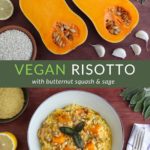
Becky
I tried this recipe as directed, including the addition of fried sage on top, and it was fantastic! I will definitely use it as my go-to butternut squash risotto recipe. It is more flavorful than other vegan risotto recipes I've made in the past.
The Pesky Vegan
Great to hear you enjoyed it, fried sage is always good!
Amber-Sophie Dugdale
Super tasty, lovely dish! And easy to make! Love the seeds on top works really well!! We made extra and used pine nuts on top when we ran our of the seeds 🙂
The Pesky Vegan
Cheers for the review Amber - pine nuts are always a good idea!
Liz
Just finished eating this! It was delicious, thanks for another easy, fun to follow recipe.
The Pesky Vegan
Great to hear you enjoyed it Liz, cheers for the review!
Laura
Okay I’m gonna say right at the top that I haven’t made this yet. I’m soooo going to though. I’m giving it five stars because a) it looks delicious and 2) I have faith in your masterpieces, and another thing) your writing style always makes me smile and or sometimes laugh out loud. Thanks for doing you, boo.
The Pesky Vegan
Thanks for the kind words Laura! Glad you have faith and hoping I can hang onto the five-star review once you've actually got round to making it :/